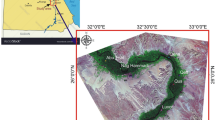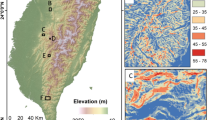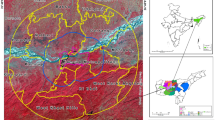Abstract
Land cover change in the semi-arid environment of the eastern Hindu Kush region is driven by anthropogenic activities and environmental change impacts. Natural hazards, such as floods presumably influenced by climatic change, cause abrupt change of land cover. So far, little research has been conducted to investigate the spatiotemporal aspects of this abrupt change in the valleys. In order to explore the abrupt change in land cover and floods as its possible drivers in the eastern Hindu Kush, a semi-arid mountain region characterized by complex terrain, vegetation variation, and precipitation seasonality, we analyzed long-term Landsat image time series from 1988 to 2020 using Breaks For Additive Seasonal and Trend (BFAST). Overall, BFAST effectively detected abrupt change by using Landsat-derived Modified Soil Adjusted Vegetation Index (MSAVI). The results of our study indicate that approximately 95% of the study area experienced at least one abrupt change during 1988–2020. The years 1991, 1995, 1998, 2007, and 2016 were detected as the peak years, with the peaks occurring in different seasons. The annual trend of abrupt change is decreasing for the study area. The seasonality of abrupt change at the catchment level shows an increasing trend in the spring season for the southern catchments of Panjkora and Swat. The spatial distribution patterns show that abrupt change is primarily concentrated in the floodplains indicating that flooding is the primary driver of the land cover change in the region. We also demonstrated the accurate detection of past flood events (2015) based on the two case examples of Ayun, Rumbur, and Kalash valleys. The detection of the flood events was verified by fieldwork and historical high-resolution Google Earth imagery. Finally, our study provides an example of applying Landsat time series in a dry mountain region to detect abrupt changes in land cover and analyze impact of natural hazards such as floods.
Article PDF
Similar content being viewed by others
Avoid common mistakes on your manuscript.
References
Ahmad S, Israr M, Liu S, et al. (2018) Spatio-temporal trends in snow extent and their linkage to hydro-climatological and topographical factors in the Chitral River Basin (Hindukush, Pakistan). Geocarto Int 35(7): 711–734. https://doi.org/10.1080/10106049.2018.1524517
Allen SK, Linsbauer A, Randhawa SS, et al. (2016) Glacial lake outburst flood risk in Himachal Pradesh, India: an integrative and anticipatory approach considering current and future threats. Nat Hazard 84(3): 1741–1763. https://doi.org/10.1007/s11069-016-2511-x
Anderson K, Fawcett D, Cugulliere A, et al. (2020) Vegetation expansion in the subnival Hindu Kush Himalaya. Glob Chang Biol 26(3): 1608–1625. https://doi.org/10.1111/gcb.14919
Ashraf A, Naz R, Roohi R (2012) Glacial lake outburst flood hazards in Hindukush, Karakoram and Himalayan Ranges of Pakistan: implications and risk analysis. Geomatics Nat Hazards Risk 3(2): 113–132. https://doi.org/10.1080/19475705.2011.615344
Ashraf A, Roohi R Naz R et al. (2014) Monitoring cryosphere and associated flood hazards in high mountain ranges of Pakistan using remote sensing technique. Nat Hazard 73(2): 933–949. https://doi.org/10.1007/s11069-014-1126-3
Ashraf A, Iqbal MB, Mustafa N, et al. (2021) Prevalent risk of glacial lake outburst flood hazard in the Hindu Kush-Karakoram-Himalaya region of Pakistan. Environ Earth Sci 80(12). https://doi.org/10.1007/s12665-021-09740-1
Atta-ur-Rahman, Khan AN (2011) Analysis of flood causes and associated socio-economic damages in the Hindukush region. Nat Hazard 59(3): 1239–1260. https://doi.org/10.1007/s11069-011-9830-8
Atta-ur-Rahman, Khan AN (2013) Analysis of 2010-flood causes, nature and magnitude in the Khyber Pakhtunkhwa, Pakistan. Nat Hazard 66(2): 887–904. https://doi.org/10.1007/s11069-012-0528-3
Baig MA, Zaman Q, Baig SA, et al. (2021) Regression analysis of hydro-meteorological variables for climate change prediction: A case study of Chitral Basin, Hindukush region. Sci Total Environ 793: 1–7. https://doi.org/10.1016/j.scitotenv.2021.148595
Brown ME, Pinzon JE, Didan K, et al. (2006) Evaluation of the consistency of long-term NDVI time series derived from AVHRR, SPOT-vegetation, SeaWiFS, MODIS, and Landsat ETM+ sensors. IEEE Trans Geosci Remote Sens 44(7): 1787–1793. https://doi.org/10.1109/TGRS.2005.860205
Bown ME, de Beurs KM, Marshall M (2012) Global phenological response to climate change in crop areas using satellite remote sensing of vegetation, humidity and temperature over 26years. Remote Sens Environ 126: 174–183. https://doi.org/10.1016/j.rse.2012.08.009
Campbell JB (2011) Introduction to remote sensing. Guilford Press, New York.
Chen L, Michishita R, Xu B (2014) Abrupt spatiotemporal land and water changes and their potential drivers in Poyang Lake, 2000–2012. ISPRS J Photogramm Remote Sens 98: 85–93. https://doi.org/10.1016/j.isprsjprs.2014.09.014
Elalem S, Pal I (2015) Mapping the vulnerability hotspots over Hindu-Kush Himalaya region to flooding disasters. Weather Clim Extremes 8: 46–58. https://doi.org/10.1016/j.wace.2014.12.001
Fang X, Zhu Q, Ren L, et al. (2018) Large-scale detection of vegetation dynamics and their potential drivers using MODIS images and BFAST: A case study in Quebec, Canada. Remote Sens Environ 206: 391–402. https://doi.org/10.1016/j.rse.2017.11.017
Franklin SE, Ahmed OS, Wulder MA, et al. (2015) Large Area Mapping of Annual Land Cover Dynamics Using Multitemporal Change Detection and Classification of Landsat Time Series Data. Can J Remote Sens 41(4): 293–314. https://doi.org/10.1080/07038992.2015.1089401
Gadgil S, Vinayachandran PN, Francis PA, et al. (2004) Extremes of the Indian summer monsoon rainfall, ENSO and equatorial Indian Ocean oscillation. Geophys Res Lett 31(12). https://doi.org/10.1029/2004GL019733
Gaurav K, Sinha R, Panda PK (2011) The Indus flood of 2010 in Pakistan: a perspective analysis using remote sensing data. Nat Hazard 59(3): 1815–1826. https://doi.org/10.1007/s11069-011-9869-6
Geng L, Che T, Wang X, et al. (2019) Detecting Spatiotemporal Changes in Vegetation with the BFAST Model in the Qilian Mountain Region during 2000–2017. Remote Sens 11(2): 103. https://doi.org/10.3390/rs11020103
Gholamnia M, Khandan R, Bonafoni S, et al. (2019) Spatiotemporal Analysis of MODIS NDVI in the Semif-Arid Region of Kurdistan (Iran). Remote Sens 11(14): 1723. https://doi.org/10.3390/rs11141723
Gioli G, Khan T, Bisht S, et al. (2014) Migration as an Adaptation Strategy and its Gendered Implications: A Case Study From the Upper Indus Basin. Mt Res Dev 34(3): 255–265. https://doi.org/10.1659/MRD-JOURNAL-D-13-00089.1
Haq M, Akhtar M, Muhammad S, et al. (2012) Techniques of Remote Sensing and GIS for flood monitoring and damage assessment: A case study of Sindh province, Pakistan. Egypt J Remote Sens Space Sci 15(2): 135–141. https://doi.org/10.1016/j.ejrs.2012.07.002
Haq F, Rahman F, Tabassum I, et al. (2018) Forest Dilemma in the Hindu Raj Mountains Northern Pakistan: Impact of Population Growth and Household Dynamics. Small-scale Forestry 17(3): 323–341. https://doi.org/10.1007/s11842-018-9390-9
Hewitt K (1992) Mountain Hazards. GeoJournal 27(1): 47–60
Hewitt K, Mehta M (2012) Rethinking risk and disasters in mountain areas. Rev geogr alp (100-1). https://doi.org/10.4000/rga.1653
Huang Q, Long D, Du MD, et al. (2018) Discharge estimation in high-mountain regions with improved methods using multisource remote sensing: A case study of the Upper Brahmaputra River. Remote Sens Environ 219: 115–134. https://doi.org/10.1016/j.rse.2018.10.008
Kamp U, Haserodt K, Shroder JF (2004) Quaternary landscape evolution in the eastern Hindu Kush, Pakistan. Geomorphology 57(1–2): 1–27. https://doi.org/10.1016/S0169-555X(03)00080-1
Ketchen DJ, Shook CL (1996) The application of cluster analysis in strategic management research: an analysis and critique. Strateg Manag J 17(6): 441–458
Khalid Z, Meng XM, Rana IA, et al. (2021) Holistic Multidimensional Vulnerability Assessment: An empirical investigation on rural communities of the Hindu Kush Himalayan region, Northern Pakistan. Int J Disaster Risk Reduct 62. https://doi.org/10.1016/j.ijdrr.2021.102413
Khan MA, Haneef M, Khan AS, et al. (2013) Debris-flow hazards on tributary junction fans, Chitral, Hindu Kush Range, northern Pakistan. J Asian Earth Sci 62: 720–733. https://doi.org/10.1016/j.jseaes.2012.11.025
Lambert J, Drenou C, Denux J-P, et al. (2013) Monitoring forest decline through remote sensing time series analysis. GISci Remote Sens 50(4): 437–457. https://doi.org/10.1080/15481603.2013.820070
Latif Y, Yaoming M, Yaseen M (2018) Spatial analysis of precipitation time series over the Upper Indus Basin. Theor. Appl. Climatol. 131(1–2): 761–775. https://doi.org/10.1007/s00704-016-2007-3
Lu L, Yuan W, Su C, et al. (2022) Study on the early warning and forecasting of flash floods in small watersheds based on the rainfall pattern of risk probability combination. Stochastic Environ Res Risk Assess 36(1): 1–16. https://doi.org/10.1007/s00477-021-02059-0
Ma JS, Song CQ, Wang YJ (2021) Spatially and Temporally Resolved Monitoring of Glacial Lake Changes in Alps During the Recent Two Decades. Front Earth Sci 9. https://doi.org/10.3389/feart.2021.723386
Maharjan A, Tuladhar S, Hussain A, et al. (2021) Can labour migration help households adapt to climate change? Evidence from four river basins in South Asia. Clim Dev 13(10): 879–894. https://doi.org/10.1080/17565529.2020.1867044
Milani G, Kneubuhler M, Tonolla D, et al. (2020) Characterizing Flood Impact on Swiss Floodplains Using Interannual Time Series of Satellite Imagery. IEEE J Sel Top Appl Earth Obs Remote Sens 13: 1479–1493. https://doi.org/10.1109/JSTARS.2020.2980381
Mishra NB, Chaudhuri G (2015) Spatio-temporal analysis of trends in seasonal vegetation productivity across Uttarakhand, Indian Himalayas, 2000–2014. Appl Geogr 56: 29–41. https://doi.org/10.1016/j.apgeog.2014.10.007
Nibanupudi HK, Shaw R (2015) Mountain Hazards and Disaster Risk Reduction. Springer Japan, Tokyo.
Nüsser M (2001) Understanding cultural landscape transformation: a re-photographic survey in Chitral, eastern Hindukush, Pakistan. Landscape Urban Plann 57(3–4): 241–255. https://doi.org/10.1016/S0169-2046(01)00207-9
Nüsser M, Dickoré WB (2002) A tangle in the triangle: vegetation map of the eastern Hindukush (Chitral, northern Pakistan). Erdkunde 56(1): 37–59. https://doi.org/10.3112/erdkunde.2002.01.03
Panday PK, Ghimire B (2012) Time-series analysis of NDVI from AVHRR data over the Hindu Kush-Himalayan region for the period 1982–2006. Int J Remote Sens 33(21): 6710–6721. https://doi.org/10.1080/01431161.2012.692836
PDMA (2015) Chitral Floods 2015: Recovery Needs Assessment and Action Framework. Provincial Disaster Management Authority, Peshawar.
PMD (2020) Chitral Monthly Meteorological Data: 1970–2019. Pakistan Meteorological Department, Islamabad. https://www.pmd.gov.pk/en/
Qi J, Chehbouni A, Huete AR, et al. (1994) A Modified Soil Adjusted Vegetation Index. Remote Sens Environ 48: 119–126.
R Core Team (2020) R: A Language and Environment for Statistical. R Foundation for Statistical Computing. https://www.R-project.org
Rehman G, Ahmad S, Khan SD, et al. (2014) Threat of glacial lake outburst flood to Tehsil Gupis from Khukush Lake, District Ghizer, Gilgit Baltistan, Pakistan. Nat Hazard 70(2): 1589–1602. https://doi.org/10.1007/s11069-013-0893-6
Running SW, Loveland TR, Pierce LL, et al. (1995) A remote sensing based vegetation classification logic for global land cover analysis. Remote Sens Environ 51(1): 39–48. https://doi.org/10.1016/0034-4257(94)00063-S
Rusk J, Maharjan A, Tiwari P, et al. (2022) Multi-hazard susceptibility and exposure assessment of the Hindu Kush Himalaya. Sci Total Environ 804. https://doi.org/10.1016/j.scitotenv.2021.150039
Rußwurm M, Körner M (2020) Self-attention for raw optical Satellite Time Series Classification. ISPRS J Photogramm Remote Sens 169: 421–435. https://doi.org/10.1016/j.isprsjprs.2020.06.006
Sati VP (2022) Glacier bursts-triggered debris flow and flash flood in Rishi and Dhauli Ganga valleys: A study on its causes and consequences. Nat Hazard Res. https://doi.org/10.1016/j.nhres.2022.01.001
Shah SH (2015) Rapid Assessment Report: Flash Flood Wreak Havoc in District Chitral. Justice, Aid, and Development (JAD) Foundation, Chitral.
Shah SH (2016) Chitral: A Year After Devastation. Justice, Aid, and Development (JAD) Foundation, Chitral.
Shahid M, Rahman KU (2021) Identifying the Annual and Seasonal Trends of Hydrological and Climatic Variables in the Indus Basin Pakistan. Asia-Pac J Atmos Sci 57(2): 191–205. https://doi.org/10.1007/s13143-020-00194-2
Shan Z, Li Z, Dong X (2021) Impact of glacier changes in the Himalayan Plateau disaster. Ecol Inf 63: 101316. https://doi.org/10.1016/j.ecoinf.2021.101316
Syed FS, Giorgi F, Pal JS, et al. (2006) Effect of remote forcings on the winter precipitation of central southwest Asia part 1: observations. Theor. Appl. Climatol. 86(1–4): 147–160. https://doi.org/10.1007/s00704-005-0217-1
Tian F, Brandt M, Liu YY, et al. (2016) Remote sensing of vegetation dynamics in drylands: Evaluating vegetation optical depth (VOD) using AVHRR NDVI and in situ green biomass data over West African Sahel. Remote Sens Environ 177: 265–276. https://doi.org/10.1016/j.rse.2016.02.056
Tsering K, Shakya K, Matin MA, et al. (2021) Enhancing Flood Early Warning System in the HKH Region. In: Earth Observation Science and Applications for Risk Reduction and Enhanced Resilience in Hindu Kush Himalaya Region. Springer, Cham, pp 169–200.
USGS (2015) Landsat surface reflectance data (ver. 1.1, March 27, 2019): U.S. Geological Survey Fact Sheet 2015–3034: 1. https://doi.org/10.3133/fs20153034
Ullah S, Farooq M, Shafique M, et al. (2016) Spatial assessment of forest cover and land-use changes in the Hindu-Kush mountain ranges of northern Pakistan. J Mt Sci 13(7): 1229–1237. https://doi.org/10.1007/s11629-015-3456-3
Veh G, Korup O, Roessner S, et al. (2018) Detecting Himalayan glacial lake outburst floods from Landsat time series. Remote Sens Environ 207: 84–97. https://doi.org/10.1016/j.rse.2017.12.025
Verbesselt J, Hyndman R, Newnham G, et al. (2010) Detecting trend and seasonal changes in satellite image time series. Remote Sens Environ 114(1): 106–115. https://doi.org/10.1016/j.rse.2009.08.014
Verbesselt J, Zeileis A, Hyndman R (2014) Breaks For Additive Season and Trend (BFAST). https://cran.r-project.org/web/packages/bfast/bfast.pdf
Watts LM, Laffan SW (2014) Effectiveness of the BFAST algorithm for detecting vegetation response patterns in a semiarid region. Remote Sens Environ 154: 234–245. https://doi.org/10.1016/j.rse.2014.08.023
Webster PJ, Toma VE, Kim H-M (2011) Were the 2010 Pakistan floods predictable? Geophys Res Lett 38(4). https://doi.org/10.1029/2010GL046346
Wester P, Mishra A, Mukherji A, et al. (2019) The Hindu Kush Himalaya Assessment: Mountains, Climate Change, Sustainability and People. Springer International Publishing, Cham.
Wu L, Li Z, Liu X, et al. (2020) Multi-Type Forest Change Detection Using BFAST and Monthly Landsat Time Series for Monitoring Spatiotemporal Dynamics of Forests in Subtropical Wetland. Remote Sens 12(2): 341. https://doi.org/10.3390/rs12020341
Xu L, Yu G, Tu Z, et al. (2020) Monitoring vegetation change and their potential drivers in Yangtze River Basin of China from 1982 to 2015. Environ Monit Assess 192(10): 642. https://doi.org/10.1007/s10661-020-08595-6
Yan J, Wang L, Song W, et al. (2019) A time-series classification approach based on change detection for rapid land cover mapping. ISPRS J Photogramm Remote Sens 158: 249–262. https://doi.org/10.1016/j.isprsjprs.2019.10.003
Yan SY, Li Y, Li ZG, et al. (2018) An insight into the surface velocity of Inylchek Glacier and its effect on Lake Merzbacher during 2006–2016 with Landsat time-series imagery. Environ Earth Sci 77(23). https://doi.org/10.1007/s12665-018-7964-7
Yaseen M, Ahmad I, Guo J, et al. (2020) Spatiotemporal Variability in the Hydrometeorological Time-Series over Upper Indus River Basin of Pakistan. Adv Meteorol 2020: 1–18. https://doi.org/10.1155/2020/5852760
Young NE, Anderson RS, Chignell SM, et al. (2017) A survival guide to Landsat preprocessing. Ecology 98(4): 920–932. https://doi.org/10.1002/ecy.1730
Zeb A (2019) Spatial and temporal trends of forest cover as a response to policy interventions in the district Chitral, Pakistan. Appl Geogr 102: 39–46. https://doi.org/10.1016/j.apgeog.2018.12.002
Zheng GX, am Bao, Li JL, et al. (2019) Sustained growth of high mountain lakes in the headwaters of the Syr Darya River, Central Asia. Glob Planet Change 176: 84–99. https://doi.org/10.1016/j.gloplacha.2019.03.004
Zhu Z (2017) Change detection using landsat time series: A review of frequencies, preprocessing, algorithms, and applications. ISPRS J Photogramm Remote Sens 130: 370–384. https://doi.org/10.1016/j.isprsjprs.2017.06.013
Zhu Z (2019) Science of Landsat Analysis Ready Data. Remote Sens 11(18): 2166. https://doi.org/10.3390/rs11182166
Acknowledgements
The authors would like to thank USGS and NASA for providing ASTER GDEM Version 3 and Landsat data, Google for Google Earth imagery and Pakistan Meteorological Department for meteorological data. We are also thankful to Prof. Marcus Nüsser (Heidelberg University) for providing the photograph of Ayun, Muhammad Usman Munir (University of Bayreuth) for helping with references, and Andrew Mitchell (University of Bayreuth) for proofreading the manuscript. Thanks also go to the two anonymous reviewers and editors whose comments and suggestions improved this manuscript.
Funding
Funding note: Open Access funding enabled and organized by Projekt DEAL.
Author information
Authors and Affiliations
Corresponding author
Electronic Supplementary Material
Rights and permissions
Open Access This article is licensed under a Creative Commons Attribution 4.0 International License, which permits use, sharing, adaptation, distribution and reproduction in any medium or format, as long as you give appropriate credit to the original author(s) and the source, provide a link to the Creative Commons license, and indicate if changes were made. The images or other third party material in this article are included in the article’s Creative Commons license, unless indicated otherwise in a credit line to the material. If material is not included in the article’s Creative Commons license and your intended use is not permitted by statutory regulation or exceeds the permitted use, you will need to obtain permission directly from the copyright holder. To view a copy of this license, visit http://creativecommons.org/licenses/by/4.0/.
About this article
Cite this article
Khan, S.A., Vanselow, K.A., Sass, O. et al. Detecting abrupt change in land cover in the eastern Hindu Kush region using Landsat time series (1988–2020). J. Mt. Sci. 19, 1699–1716 (2022). https://doi.org/10.1007/s11629-021-7297-y
Received:
Revised:
Accepted:
Published:
Issue Date:
DOI: https://doi.org/10.1007/s11629-021-7297-y




